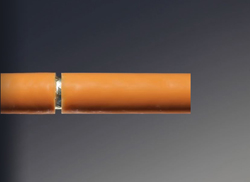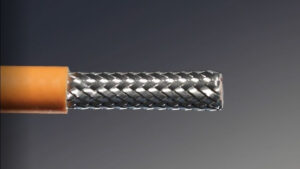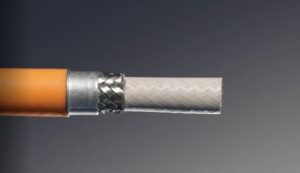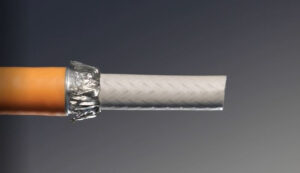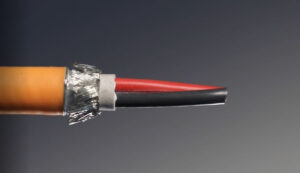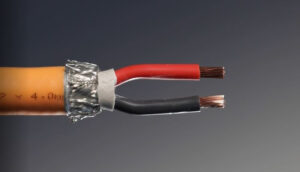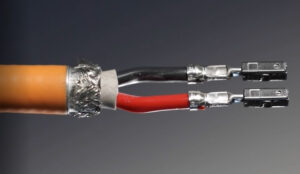BY ROB BOYD, SENIOR PRODUCT MANAGER, SCHLEUNIGER, INC.
Electric Vehicle (EV) cable harnesses is one of the hottest topics in the world of wire processing today. It’s a very new and exciting market that is changing rapidly as new techologies emerge. For those looking to expand into this market, it is importnant to understand the process of effectively automating high voltage (HV) cable connector assemblies.
High voltage connectors used in EV applications have many components, therefore there are several process steps that must be performed in a specific sequence. While most customers want to automate every process step, often times the cost of a fully automatic system cannot be justified.
Some process steps are more challenging and require more precision. For instance, removing the foil layer or cutting the shield is more critical because connector performance or safety may be affected significantly. Furthermore, some process steps are required for almost all connectors and cable types whereas other process steps are required only for certain connectors. Depending on the volume of a particular connector series, it might make more sense to automate only the critical or common steps and continue the simpler or uncommon steps with manual processes. However, it can all be automated if the volumes justify it.
Currently more than 97% of HV applications require shielded cables, whether they be multi-conductor or coaxial cables. HV applications range from 3mm2 up to 120mm2 in single-conductor (coaxial) or 2×2.5mm2 up to 5×6.0 mm2in multi-conductor cables for a tremendous variety of single- and multi-cable connectors. Therefore, customers who are serious about expanding their offering into HV cable assemblies must look at automation solutions that provide not only high precision but complete flexibility so that any investments are protected knowing that processing requirements can change in the future. It is important that systems can be expanded in the field so they can grow and adapt with your business.
Different connectors often have very different individual process steps because of their different functions and/or constructions. However, there are some basic steps that apply to almost all of them and these steps pertain to properly stripping the cable and loading the ferrules.
- Remove outer jacket & foil
Cables without a foil layer around the shield are naturally easier and faster to strip. These cables can be stripped with radiused fixed blades, rotary stripping blades, or a laser stripper.
Radiused fixed blades will likely be the fastest but perhaps not the safest for quality. If one blade is sharper than the other, the blades will not penetrate the insulation evenly and may damage the shield. If the cable is not very concentric, it is nearly impossible not to damage the shield. Finally, changing to a different cable size requires a blade size change as well.
Laser stripping is popular since there is no way to damage the shield because the laser beam is reflected off of the shield. However, if the shield is not woven tightly, the laser can penetrate the shield and damage the inner layers. Laser strippers require fume extraction since some fumes are toxic. They are also the most expensive, compared to other stripping methods.
Rotary stripping will provide the cleanest cut using blades and conductor detection systems that can prevent damage to the shield. Special processes can be used for non-concentric cables.
When the outer jacket is molded into the shield, it makes it more difficult to remove the jacket without disturbing the shield. For these cases, manipulating the slug in certain directions while pulling it off of the cable helps the slug break away from the shield.
If the cable has a foil layer, it must be stripped cleanly, flush with the outer jacket with no flags remaining. This is nearly impossible with fixed blades. It is certainly possible with a laser system unless the foil is bonded to the outer jacket. Laser systems require space for the laser to get to the foil. However, if the foil is bonded to the outer jacket, any pulling of the slug may cause the foil to tear unevenly. Furthermore, lasers will not cut where the foil overlaps.
With rotary stripping blades, it is possible to score the foil without pulling the slug. The jacket slug and foil can be removed simultaneously by manipulating the cable and twisting the slug as it is removed. The result is a clean foil cut that is flush with the outer jacket.
- Assembling the inner ferrule
Loading the ferrule onto the cable is critical but not overly challenging if done manually. However, as mentioned, different connectors use different ferrules. Therefore, it should be possible to change over to different ferrules with a few cable- and ferrule-specific parts. The system should also have the ability to detect if the ferrule is the correct type and if it is properly oriented on the cable.
Installing the ferrule onto the cable is a step that could be done manually to save costs since automatic loading systems are quite expensive.
- Cutting/removal of the shield
Properly cutting the shield consistently with a traditional rotary stripping unit is very challenging for HV cables especially if the cable has nonconcentric layers or is otherwise out-of-round. The integrity of the dielectric and filler are critical for proper performance of the cable and traditional rotary stripping machines risk damaging the inner layers. An anvil and punch system guarantees the inner layers will not be damaged and cuts the shield cleanly and evenly, 360° around the cable.
The resulting shield length will depend upon the ferrule being used since it will be wrapped around it. The cut must be clean and consistent, otherwise long strands may cause shorts with other components and short strands may degrade the integrity of the ferrule crimp.
Sometimes the shield length is longer than the length of the dielectric. These applications require that the shield is opened and folded back after it is trimmed so that the inner layers can be stripped.
- Fold shield
The shield gets folded back over the ferrule but in some cases, not completely. Different connectors require different fold angles to ensure the connector fits together properly. The fold angle may be between 90° to 180° but the fold must be even, 360° around the ferrule. The shield strand ends must fall within the specified tolerances to ensure proper performance. Strands that are too may cause shorts and short strands might not secure the shield properly when the outer ferrule is crimped.
- Removing dielectric/filler
The dielectric or filler can be removed in the same way as the outer jacket. Multi-conductor cables are not allowed to have any damage to the conductor insulation.
For coaxial cables, conductor detection can play a big role to ensure the center conductor is not damaged by the stripping blades. As with the outer jacket, the system must be able to accommodate non-concentric cables to provide the most flexibility.
- Multi-conductor orientation and stripping
Prior to terminating multi-conductor cables, the cable must be oriented properly so that polarity is correct when the conductors are plugged into the connector. Sophisticated systems must be able to recognize the wire colors and then rotate the cable accordingly without losing cable position.
Once oriented properly, the conductors are formed to enable termination and according to the connector cavity pitch. Once the conductors are properly formed, the ends should be stripped on a device with conductor detection to ensure the wire strands are not damaged.
- Termination
Inner conductors are either crimped or ultrasonically welded to the terminals. Automation systems can integrate suitable crimping presses with crimp force monitoring systems. Ultrasonic welding systems typically have integrated monitoring to ensure a proper weld.
Automation systems that can integrate 3rd party systems are very convenient. These systems can minimize the validation process for presses and welding systems that have already gone through lengthy approval processes.
- Multi-conductor connector loading
For multi-conductor cables that will be terminated and loaded into a connector, it is critical that the wire ends and terminal positioning are very consistent. This will ensure that the terminals will load and lock into the connectors properly.
Subsequent housings or components can be applied automatically and locked into position if volumes justify it. However, steps 1 through 4 and 6 listed above are the most common process steps for the widest variety of applications. Automating these process steps will likely give you the best return on investment since they are most commonly applied. These steps are also the most critical to ensure proper connector performance.
New visual inspection systems inspect 360° around the cable. Artificial intelligence is utilized to identify the different layers of the cable assembly to perform a thorough analysis. Numerous quality characteristics can be programmed for each assembly.
When inquiring about an automatic HV Cable Connectorization system, be prepared with the following information for all the applications you will want to run:
- Cable specifications and stripping requirements
- Connector specifications and the necessary process steps
- Quality assurance requirements
- Production requirements and/or required cycle times
With this information, the automation supplier will be able to provide recommendations on the most cost effective system for your production requirements along with the expected performance, be it a semi-automatic or a fully automatic system.
Considering how fast EV technology is evolving, automation systems should be flexible and adaptable in the field, at your facility, without major interruptions in production. For instance, it should be possible to move semi-automatic stations onto a fully automatic platform. Similarly, the fully automatic platform should be expandable as volumes increase over time. This feature will give you the most flexibility and enable you to leverage your investment moving forward.
This article can be found in the Sep/Oct 2021 Issue of Wiring Harness News.


